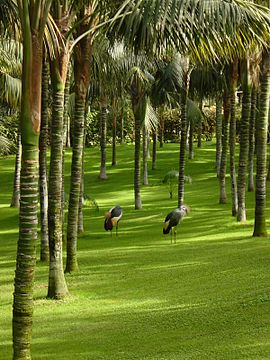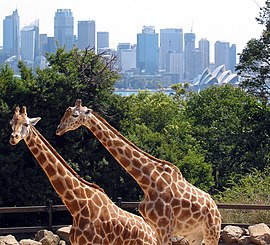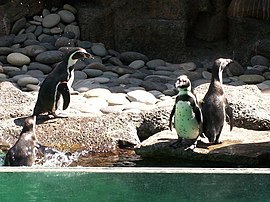Zoo Garden
A zoological garden, zoological park, menagerie, zoo, or zoo b>, is an installation in which animals are exhibited within enclosures exposed to the public and in which they can also be raised.
The term zoological garden refers to zoology, the study of animals, a term derived from the Greek zωο (zoo: "animal&# 34;) and λóγος (lógos: "study"). Currently the number of animal collections open to the public worldwide exceeds 1,000, around 80% of them in cities.
Etymology
At its opening in 1828, London Zoo billed itself as a "menagerie" or "zoological garden". The abbreviation "zoo" first came into use in a print made in the United Kingdom. United in about 1847, to refer to Clifton Zoo. However, it was not until two decades later that it became popular, due to the cultural impact of the song "Walking in the Zoo on Sunday" performed by the music hall artist Alfred Vance. the term "zoo" was used for larger facilities located in Washington D.C. and New York, opened in the 1890s.
History
Animal collections and zoos already appear in the Chinese and Egyptian civilizations,[citation needed] at the same time as throughout history all civilizations that have been developed have left in one way or another evidence of the man-animal relationship.
The first zoos were actually private collections of live exotic animals, collections mostly belonging to kings. In this sense, the first zoo of which there is reliable news was the Moctezuma zoo that the Aztec emperor had in his capital Tenochtitlán, and which was described by Hernán Cortés in 1520 and destroyed shortly thereafter[citation required]. More than a century later, in 1664, the first European zoo was inaugurated: the ménagerie royale de Versailles ("Royal menagerie of Versailles"), conceived by Louis Le Vau for Louis XIV. The first modern zoo was the Vienna Zoo, inaugurated in 1765.[citation needed] Three decades later, in 1793, the French Revolution dissolved the Versailles menagerie and reinstated the animals in a new zoo, thus opening to the public what is now considered the second oldest zoo in the world, the ménagerie ("menagerie") of the Garden of Plants, in Paris, governed since then by the National Museum of Natural History of France. Eventually, in 1934, this French national museum opened a larger zoo, on the municipal border of Paris, the Paris Zoo, which has since become the official zoo of the city, although the former menagerie of the Garden de Plantas was never closed and is still open today, thus completing each other with the official zoo.
The Central Park Zoo was opened in New York in 1864. It is the oldest zoo in the United States and has one of the largest collections in the world. Cities such as Saint Louis (Missouri), Bombay, Tokyo, Madrid, Rome, Berlin, San Diego, Chicago, Philadelphia or Munich house collections of great importance. In Latin America, some of the most important are the Buin Zoo and the National Zoo in Chile, the Parque de las Leyendas in Peru, the Chapultepec Zoo, the Miguel Álvarez del Toro Zoo and the Guadalajara Zoo in Mexico, the Matecaña Zoo and the Cali in Colombia, the Buenos Aires Zoo in Argentina, the El Pantanal Zoo in Ecuador and the La Aurora Zoo in Guatemala.
Over time, the mission of zoos has evolved from the mere exhibition of exotic animals to the scientific study of animals (London Zoo was the world's first scientific zoo) and, later, captive breeding and in particular the protection of species in danger of extinction or even already extinct in the wild, such as the California condor, the Hawaiian goose, the hermit ibis and the panda bear.
Types of zoos
In a zoo, animals live in enclosures designed in such a way that they resemble their natural habitats or allow the development of stable behavior patterns, to ensure their well-being. In the case of nocturnal species —those that are more active at night— special buildings are built that provide dim white or red lights during the day so that the animals are active and can be observed by visitors, and lights brighter at night for them to sleep. Regarding animals that live in extreme environments, such as penguins, it is necessary to house them in structures with specific climatic conditions. There is a type of enclosure for each species, from insects and birds to reptiles, mammals and aquatic creatures. Some facilities are even adapted so that visitors can enter and touch animals that are not violent; under the condition that they stay on a previously identified path during the tour, and that they do not feed or even show food to the animals.
Legislation
World
The Convention on Biological Diversity is the first international legal instrument that includes as mechanisms for the protection of biological and genetic resources the terms in situ conservation (conservation of ecosystems and natural habitats and the maintenance and recovery of viable populations of species in their natural environments) and ex situ (financial, scientific and technical measures aimed at the conservation and research of plants, animals and microorganisms outside their natural habitat). Zoos are a clear example of facilities for ex situ conservation, they can and should be active subjects of great value in conservation.
Europe
Directive 1999/22/EC, of March 29, relative to the keeping of wild animals in zoos, requires the establishment of a system of authorization and inspection of zoos, which guarantees compliance with basic conditions of health, welfare and safety, to maintain the good physical and mental health of the wild animals that inhabit them. In this way, it intends to favor the correct application of community legislation on the conservation of wildlife, as well as to ensure the role of zoos in public education, scientific research and conservation of species.
Regulation (EC) no. obliges Member States to have adequate facilities for housing and care in the event of importation of live specimens of a large number of species, and public display of specimens of the species listed in Annex A for commercial purposes is prohibited, except in case of specific exception justified for educational, research or breeding purposes.
Council Directive 79/409/EEC of April 2, 1979, relative to the conservation of wild birds, and Council Directive 92/43/EEC of April 21, May 1992, relating to the conservation of natural habitats and wild fauna and flora, prohibit the capture, maintenance and trade of a large number of species, but allow certain exceptions, precisely for research, education and breeding, repopulation and reintroduction of species.
Spain
The European directive was transcribed in Law 31/2003, of October 27, on the conservation of wild fauna in zoos. This law establishes that zoos must be a source of scientific knowledge available to universities, institutions dedicated to research, and organizations committed to the conservation of nature, so that these entities can contribute to the conservation ex situ of wild species, as well as their in situ conservation. It also specifies that zoos should have the function of promoting education and public awareness regarding the conservation of biodiversity.
Zoo management powers are transferred to the autonomous communities, which are obliged to keep a register of authorized zoos in their territory, with up-to-date information on the collections of animals they keep in their facilities. They must also keep the Ministry of the Environment informed of the data in their records.
Facilities
Most modern zoos keep animals confined in scaled-down reproductions of their natural habitats. These microenvironments must be large enough to allow exercise and privacy for the animal. Some modern designs take into consideration both the comfort of the animal and the ease of visitors to observe them, avoiding the animals finding out about it. For this, some tricks are used, such as tinted windows behind a shelter from the sun.
In many zoological gardens there are special buildings for nocturnal animals, where a dim reddish light is projected during the day so that the animal is active during visits and a bright light at night to ensure the animal sleeps.
Zoos around the world
Almost every major city in the world has a zoo, despite the variation in size and quality of each. Larger zoos are major tourist attractions, so many governments choose to subsidize zoo operating expenses. The nationalization of zoos is also justified by their educational value, since zoos are often visited by schoolchildren on study trips. However, most of a zoo's funding comes from donations and the cost of admission to visitors.[citation required]
Conservation of threatened species
The zoo and aquarium associations -WAZA (worldwide), AAZA (America), EAZA (Europe), etc.- coordinate actions for the conservation of endangered species and carry out ex-situ reproduction projects.
In Europe the two main programs of this type are the European Endangered Species Program (EEP) and the European Stud-Book (ESB).
There are extinct species or subspecies in the wild with only individuals left in zoos. This is the case of the Father David's deer (Elaphurus davidianus) or the Atlas lion (Panthera leo leo).
Controversy
Some groups are opposed to animals being deprived of their liberty. They argue that it is unethical to use beings with the capacity to feel for the leisure of people and for this reason they call for the closure of zoos, oceanariums, and public aquariums. Most of these criticisms are not directed at zoos that contain animals at high risk of extinction, but rather towards zoos that contain animals that could be in the wild. Some zoos release the animals back into their habitats.
Zoos must meet the goals of research, recreation, education, and conservation. Therefore, a zoo should not acquire its animals by removing them from their respective habitats or buying them from hunters. In addition to purchases and trades with other parks, some zoos legally acquire animals through institutions that confiscate wild animals from wildlife dealers, collectors, hunters, or people who illegally keep them as pets. The individuals of wild fauna that arrive at the zoo are welcomed because it is their last alternative for a more or less adequate life, with specialists in their health and specific habitats. When a wild animal comes into contact with humans, it loses the chances of reintegrating into nature, for this reason the aforementioned dealers and collectors completely end the chances that the wild individual can reintegrate into its natural environment. The difficulty of reintegration lies in the following:
- Survival instincts (food, reproduction) are affected.
- Physical abuse.
- The wild animal, having prolonged contact with humans, loses their fear. This causes the release in nature to approach settlements and cities for food or shelter.
Contenido relacionado
Gorillas in the Mist
Albertosaurus sarcophagus
Cirsium









